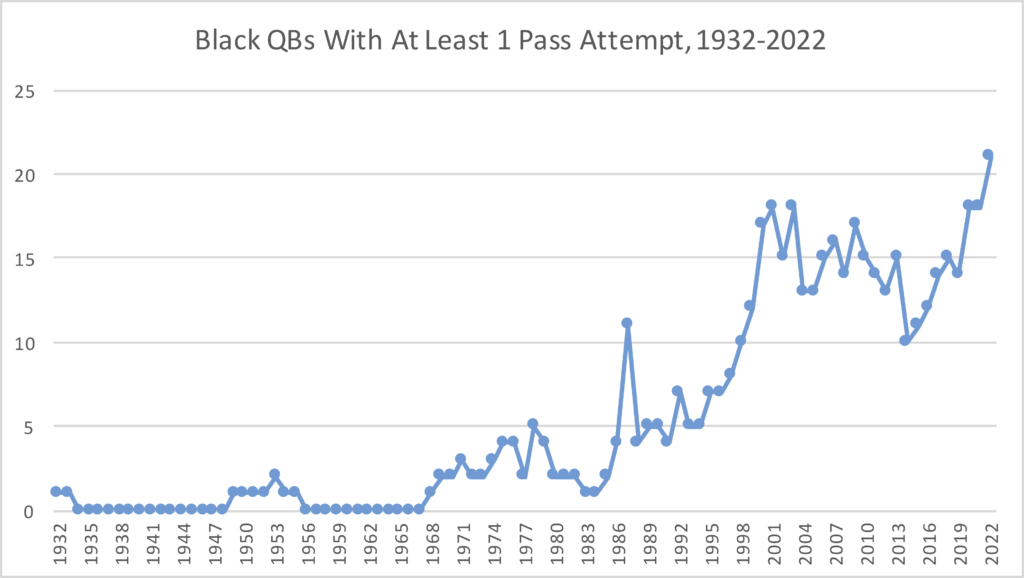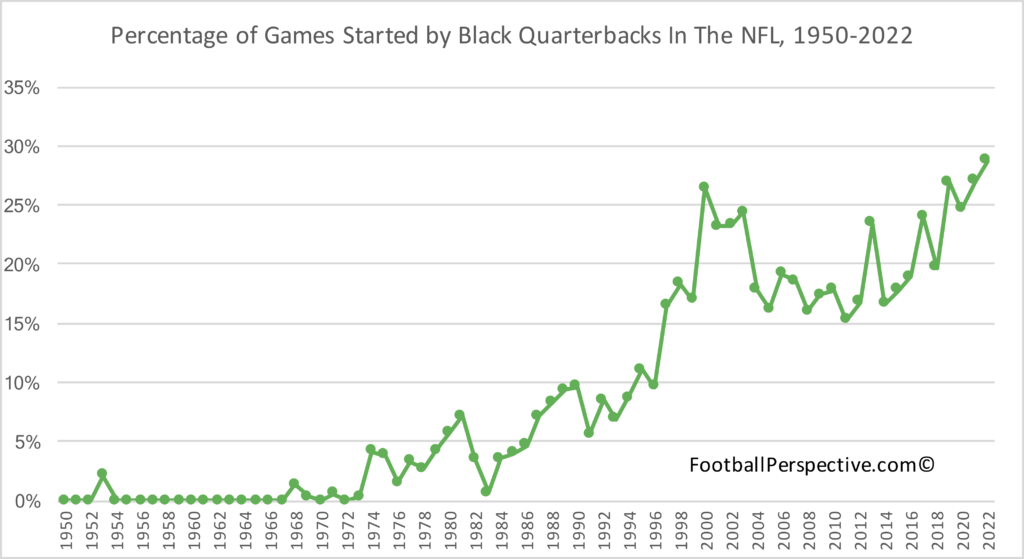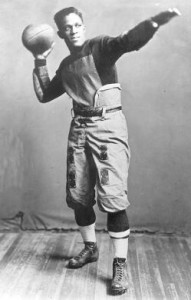The 2022 season was another groundbreaking season for black quarterbacks in the NFL. There were 21 black quarterbacks who threw at least one pass this year, the highest number in a single season in NFL history. The graph below shows how many black quarterbacks in the NFL [1]Or AFL or AAFC. threw at least one pass in each season since the league began recording passing statistics in 1932:

Black quarterbacks also started 29% of all games, another high-water mark for the league. In 2022, 15 of the league’s 32 teams started a black quarterback in at least one game, including the PFWA Comeback Player of the Year (Seattle’s Geno Smith), the Most Valuable Player in the league (Kansas City’s Patrick Mahomes) and the quarterback of the league’s best team during the regular season (Philadelphia’s Jalen Hurts).

The charts above tell a remarkable story. Consider that the year of the first Super Bowl (1966), there were no black quarterbacks in the AFL or NFL. When Tom Brady was born (1977), there had never been an NFL game where both teams started black quarterbacks. And when Brady was drafted, there had never been two black quarterbacks to face off in an NFL playoff game. Now, on the day that Brady is retiring, it’s a noteworthy sign of progress that we are just days away from the first Super Bowl featuring two black quarterbacks (Mahomes and Hurts). It has been a remarkable journey for black quarterbacks in the NFL, one that started over one hundred years ago.
The history of how the NFL has treated black quarterbacks is a complicated one. [2]Back in 2008, I wrote a four part series detailing the history of the black quarterback. Ten years ago, I updated that article, before releasing updated versions in 2020 and 2021. Today, in honor of black history month, let’s revisit the history of black quarterbacks in the NFL.
For the last 55 of those seasons, pro football had at least one black quarterback. But the history of how black players at the most high profile position goes back to the founding of the NFL. In 1920, Fritz Pollard was the tailback of the Akron Pros; a year later, he was promoted to player/coach, and became the first black head coach in NFL history. Pollard helped the Pros win the championship in the NFL’s inaugural season. [3]At the time, the NFL went by the name the American Professional Football Association. It was not known as the NFL until 1922. The Pros ran the single-wing, and Pollard was the player who lined up behind the center and received the snaps. Until 1933, the forward pass was illegal unless thrown from at least five yards behind the line of scrimmage, so Pollard barely resembles the modern quarterback outside of the fact that he threw a few touchdown passes during his career. [4]In addition to his NFL exploits, Pollard also achieved a great deal of fame for leading Brown to back-to-back road wins over the powerhouse schools of the time, Yale and Harvard, in 1916. He would … Continue reading And, of course, it was a time of significant discrimination in America and in the NFL.
Pollard and end Bobby Marshall were the first two black players in professional football history. And, as documented by Sean Lahman, at least one African American played in the NFL in every year from 1920 to 1933. But while there were several notable black players during this era, Pollard and single-wing tailback Joe Lillard [5]In 1933, Lillard had more than twice as many passing yards and rushing yards as any of his Cardinals teammates. He would then leave the NFL after the racial ban to go pitch in the Negro Leagues. were the only ones resembling a quarterback. [6]As an aside, it wasn’t just African Americans that had access during the NFL’s early days: Jim Thorpe coached and starred in a team composed entirely of Native Americans called the Oorang … Continue reading That was until the end of the 1933 season, when an informal ban on black athletes was instituted and championed by Washington Redskins owner George Marshall. It wasn’t until 1946 that black players were re-admitted to the world of professional football, when UCLA’s Kenny Washington [7]Who occupied the same backfield with the Bruins as Jackie Robinson. and Woody Strode were signed by the Los Angeles Rams; in the AAFC, Bill Willis and Marion Motley were signed by Paul Brown’s Cleveland Browns that same season.

Taliaferro became the first black player drafted in the NFL and the first black QB to start for an NFL team in the modern era.
In general, the rival league was friendlier to black players. After Indiana University’s George Taliaferro played quarterback in the AAFC in 1949, he became the the first post-World War II black quarterback when he joined the New York Yanks in 1950. [8]For what it’s worth, Kenny Washington also threw 14 passes with the Rams from ’46 through ’48. Taliaferro was a jack-of-all trades: in both 1952 and 1953, he accumulated over 200 passing, rushing and receiving yards, and scored a touchdown via all three methods. But despite making three Pro Bowls, Taliaferro never led his team in passing, and was more a utility player than a quarterback.
The next African American quarterback in the NFL was unquestionably a thrower. Literally. Unlike Pollard, Lillard and Taliaferro, Willie Thrower was listed as a quarterback, and some cite him as the first modern black quarterback in pro football history. Relieving George Blanda, Thrower threw eight passes in one game in 1953 for the Bears (and did not record a rushing attempt or a reception). Two years later, Charlie “Choo Choo” Brackins was signed by the Green Bay Packers, marking another milestone. While Pollard (Brown), Taliaferro, and Thrower (Michigan State) came from major schools, Brackins was the first in a small line of quarterbacks from historically black colleges. Brackins was drafted in ’55 out of Prairie View A&M. While Brackins would be the only quarterback drafted from an HBCU for 13 years, he paved the way for quarterbacks like Doug Williams and Steve McNair.
Brackins and Thrower combined to throw just ten passes, and the NFL did not enlist another black quarterback for twelve seasons. The late ’50s and the decade of the ’60s was a critical period for race relations in the country as well as on football fields across America. For the most part, black quarterbacks of this time who shined in high school or college were asked to switch positions in the NFL. That includes players like Pete Hall, a quarterback at Marquette, who made the familiar switch to receiver for the NFL. Another star, Sandy Stephens, led Minnesota to the Rose Bowl and was selected in the first round of the AFL draft and the second round of the NFL draft in 1962. But since both the New York Titans and Cleveland Browns wanted him to switch positions like Hall, Stephens instead moved to Canada to play quarterback in the CFL. Others, like Prairie View quarterback Jim Kearney, switched to safety, and made an impact in the NFL on the other side of the ball. In 1968, the Raiders drafted Tennessee State legend Eldridge Dickey in the first round, but they used the star college quarterback as a utility player and returner. [9]In the 12th round, another HBCU player, Fisk QB Henry Johnson — a classmate of congressman and civil rights icon John Lewis — was selected by the 49ers but never played in the NFL.
But 1968 is a turning point in NFL history: there has been at least one black quarterback in the NFL (or AFL) in every season since then. That’s because in the 14th round of that 1968 Draft, Denver selected Nebraska-Omaha’s Marlin Briscoe, who became the first black player in the Super Bowl era [10]And the first since Taliaferro started two games in 1953. to start at quarterback. Nicknamed the Magician, Briscoe nearly pulled off a remarkable 4th quarter comeback in his first NFL game. Briscoe had an impressive rookie season playing for a bad team (including a remarkable 300-yard, 4 TD game against the Bills) at a time when there was immense discrimination against black quarterbacks. [11]After the season, Denver informed Briscoe that they intended to go with Pete Liske as their quarterback in 1969 (with Steve Tensi as the backup); as a result, Briscoe asked for his release, and … Continue reading
In the fifth round of the 1969 draft, the Patriots drafted Onree Jackson. The Patriots player personnel director said “Jackson could be the Willie Mays of pro football” but he was released just months later; the only explanation provided was that Jackson “was behind the other three quarterbacks.” But another black quarterback from that draft had much more success. In the eighth round, Grambling’s James “Shack” Harris was drafted by Buffalo and was the team’s opening day starter. Harris played sparingly in ’70 and ’71, before being out of football in 1972. But he joined the Rams in 1973, and the next season became the first black quarterback to make the Pro Bowl. Keeping the streak alive in ’72 was Joe Gilliam, an 11th round pick out of Tennessee State by the Steelers. The former HBCU quarterback would play four seasons in Pittsburgh, with the majority of his work coming in 1974. That season, the year Pittsburgh won its first Super Bowl, Gilliam arguably outplayed Terry Bradshaw in the regular season, but he was unable to wrest the job from the former number one overall pick.
J.J. Jones (New York Jets), Dave Mays (Cleveland), John Walton (Philadelphia), Parnell Dickinson (Tampa Bay) and Vince Evans (Chicago) all entered the NFL in the mid-to-late ’70s, serving as a bridge until the next breakthrough. By the end of the 1977 season, black quarterbacks were no longer unfathomable, but no black quarterback had been selected before the sixth round of the draft. [12]Excluding Dickey (not drafted to play quarterback) and Dave Lewis, who was drafted as a punter. That changed when the Tampa Bay Buccaneers selected Grambling State’s Doug Williams with the 17th pick in the first round of the 1978 draft.
After Williams, no black QBs entered the league for five years. [13]Well, Tennessee State’s Joe Adams was drafted in the 12th round in 1981 but did not make the team. But one milestone occurred in the interim, when Williams and Evans became the first pair of black quarterbacks to start an NFL game in 1979. During the 1983 season, Evans was the only black quarterback in the NFL (Williams was in the USFL at the time). Evans joined Williams in the USFL after the season — that league was a bit friendlier to black quarterbacks than the NFL, as was the case with the AAFC, AFL, and CFL. That would have left the NFL without any black quarterbacks, but in 1984, the landscape of what a black quarterback could do in the NFL changed forever.
Warren Moon joined the Canadian Football League in 1978, and promptly led his Edmonton Eskimos to the Grey Cup title in each of his first five seasons. In 1983, he set the single season passing record and won the Most Outstanding Player award. That prompted the Houston Oilers to sign the future 9-time Pro Bowler and NFL Hall of Famer. Moon, who entered the NFL for his age 28 season, still ranks fifth in NFL history in passing yards gained in a player’s age 28 season and beyond. He remains underrated to this day.
Randall Cunningham was drafted in 1985, and would become a star using a different style than Moon. Cunningham is the most decorated quarterback to be passed over by the Hall of Fame. He won the Bert Bell Award as the league’s best player in 1988, 1990, and 1998. In 1990, the Pro Football Writers Association also named him their MVP, and in 1998, he received the Jim Thorpe Trophy as the league’s best player from the the Newspaper Enterprise Associates panel. Each season, Cunningham was the runner-up in the AP MVP voting, to Terrell Davis in 1998 (25 votes to 14), Joe Montana in ’90 (26 votes to 18), and Boomer Esiason in 1988 (31 votes to 21). Cunningham’s historic 1990 season saw him throw 30 touchdown passes and rush for 942 yards; until 2015, no other player with 30 passing touchdowns in a single season had rushed for even 500 yards.
After Reggie Collier was drafted by the Cowboys in 1986, a string of black QBs entered the NFL during the year of replacement players in 1987 (see the big spike that year in the graph at the top of this article). That season ended with Doug Williams breaking the ultimate ceiling, leading Washington to a Super Bowl championship and Williams earning Super Bowl MVP honors. Two years later, Rodney Peete was drafted by the Lions, and the following year, the Lions drafted Andre Ware with the seventh overall pick in the draft. Since 1989, there have been at least five black quarterback in the NFL every season. In 1995, Steve McNair out of another HBCU (Alcorn State), became the third overall draft pick, and would appear in a Super Bowl four years later. And in 1999, Donovan McNabb, Akili Smith, and Daunte Culpepper were all selected in the first 11 picks, with Shaun King going in the second round.
The next year, Michael Vick became the first black quarterback selected with the first overall pick in 2000. And on December 31, 2000, McNabb and King became the first pair of black quarterbacks to start an NFL playoff game. In 2006, Vince Young became the first black quarterback to win the AP Rookie of the Year award, paving the way for Cam Newton, Robert Griffin III, Dak Prescott, and Kyler Murray to later win that award. Vick had a controversial career but his talent was undeniable: since he broke the barrier, four other black quarterbacks (JaMarcus Russell (2007), Cam Newton (2011), Jameis Winston (2015), and Kyler Murray (2019)) have been selected first overall.
But that does not mean there are no more hurdles to clear. During the pre-draft evaluation process, some speculated that Lamar Jackson should switch positions in the NFL. Despite his obvious ability, Jackson fell to the 32nd pick of the 2018 Draft; he would be the NFL’s most valuable player just one year later. And the Super Bowl LVII quarterbacks were not overwhelming favorites of scouts, either: Mahomes fell to the 10th pick of the 2017 Draft and Hurts was the 53rd pick in 2020.
There have been many great black quarterbacks over the past 40 years, but even the success of players like Donovan McNabb and Steve McNair at times felt isolated. As recently as 2011, just 15% of all games were started by black quarterbacks. But there has been tremendous progress over the past decade. On the opening day of the 2022 season, there were 11 teams starting black quarterbacks, tied with week 5 of the 2021 season for the most in any week in NFL history. That sort of success would surely put a smile on the faces of the Throwers and Taliferros who helped build the legacy of black quarterbacks in pro football.
References
| ↑1 | Or AFL or AAFC. |
|---|---|
| ↑2 | Back in 2008, I wrote a four part series detailing the history of the black quarterback. Ten years ago, I updated that article, before releasing updated versions in 2020 and 2021. |
| ↑3 | At the time, the NFL went by the name the American Professional Football Association. It was not known as the NFL until 1922. |
| ↑4 | In addition to his NFL exploits, Pollard also achieved a great deal of fame for leading Brown to back-to-back road wins over the powerhouse schools of the time, Yale and Harvard, in 1916. He would become the first African American to be named an All-American and the prior season, he lead Brown to the Rose Bowl. |
| ↑5 | In 1933, Lillard had more than twice as many passing yards and rushing yards as any of his Cardinals teammates. He would then leave the NFL after the racial ban to go pitch in the Negro Leagues. |
| ↑6 | As an aside, it wasn’t just African Americans that had access during the NFL’s early days: Jim Thorpe coached and starred in a team composed entirely of Native Americans called the Oorang Indians in 1922 and 1923. |
| ↑7 | Who occupied the same backfield with the Bruins as Jackie Robinson. |
| ↑8 | For what it’s worth, Kenny Washington also threw 14 passes with the Rams from ’46 through ’48. |
| ↑9 | In the 12th round, another HBCU player, Fisk QB Henry Johnson — a classmate of congressman and civil rights icon John Lewis — was selected by the 49ers but never played in the NFL. |
| ↑10 | And the first since Taliaferro started two games in 1953. |
| ↑11 | After the season, Denver informed Briscoe that they intended to go with Pete Liske as their quarterback in 1969 (with Steve Tensi as the backup); as a result, Briscoe asked for his release, and signed on with the Bills as a wide receiver. In 2002, Briscoe wrote an autobiography chronicling his struggles as a black quarterback in professional football. |
| ↑12 | Excluding Dickey (not drafted to play quarterback) and Dave Lewis, who was drafted as a punter. |
| ↑13 | Well, Tennessee State’s Joe Adams was drafted in the 12th round in 1981 but did not make the team. |

